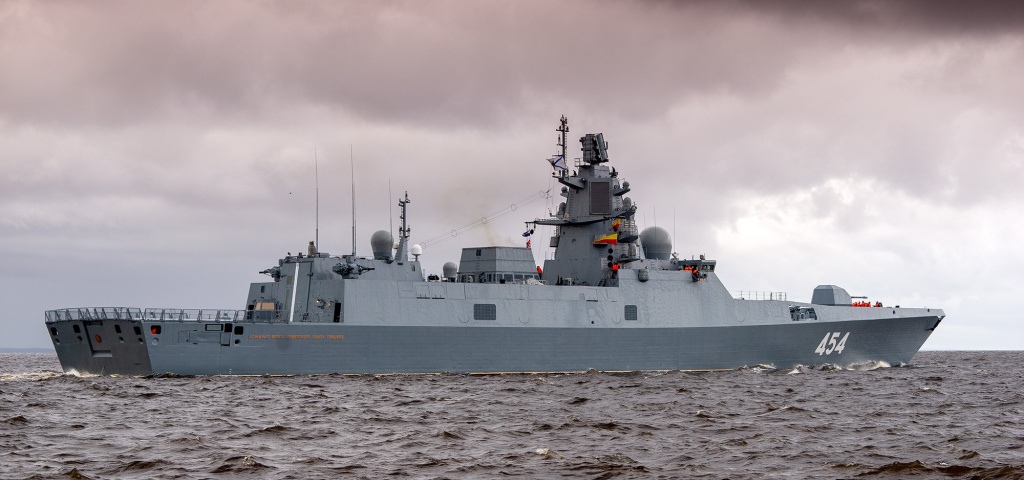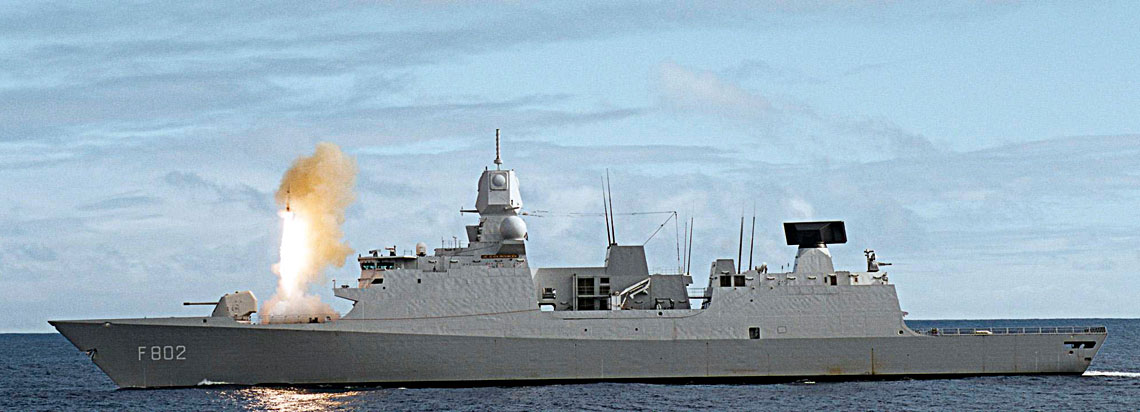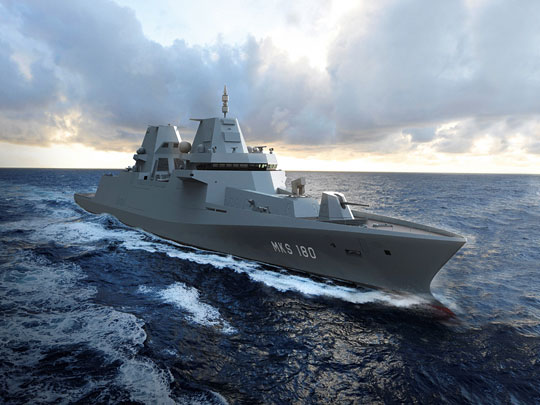
Are frigates good for everything?

A properly equipped and armed frigate could be an important, mobile component of our country's integrated air defense system. Unfortunately, in Poland, this idea was not understood by political decision-makers who opted for the purchase of conventional, immobile land systems with sectoral operation. And yet such ships could be used not only to combat air targets during a conflict - of course, assuming that the military role of the Navy, which boils down to defending our territory against aggression from the sea, is not its only raison d'être. The photo shows the De Zeven Provinciën LCF-type Dutch anti-aircraft and command frigate firing the SM-2 Block IIIA medium-range anti-aircraft missile.
Frigates are currently the most widespread in NATO, and generally in the world, class of medium-sized multi-purpose combat ships. They are operated by almost all countries of the North Atlantic Alliance with navies, as well as by numerous naval forces of other countries. Does this mean that they are "good for everything"? There are no universal perfect solutions. However, what frigates offer today allows maritime forces, in most cases, to perform the essential tasks set before them by the governments of individual countries. The fact that this solution is close to the optimal one is proved by the large and still growing number of their users.
Why are frigates such a popular class of warship all over the world? It is difficult to find an unambiguous answer. This is related to several key tactical and technical issues that are universally applicable both in the conditions of a country such as Poland, but also Germany or Canada.
They are the optimal solution in the "cost-effect" relationship. They can carry out operations in distant waters alone or in ship teams, and thanks to their size and displacement, they can be equipped with sets of various equipment and weapons - i.e. a combat system - allowing for the implementation of a wide range of tasks. Among them are: fighting air, surface, underwater and land targets. In the case of the latter, we are talking not only about hitting targets with barrel artillery fire, but also about strikes with cruise missiles on objects with known locations in the hinterland. In addition, frigates, especially those designed in recent years, can carry out non-combat missions. It is about supporting humanitarian operations or policing to enforce the law at sea.

Germany is not slowing down. The F125 type frigates are being entered into expeditionary service, and the fate of the next model, the MKS180, is already in the balance. The acronym for "multipurpose battleship" is probably just a political cover for the purchase of a series of units, the displacement of which can reach up to 9000 tons. These are not even frigates anymore, but destroyers, or at least a proposition for the wealthy. In Polish conditions, much smaller vessels could change the face of the Polish Navy, and thus our maritime policy.
Size matters
Thanks to their high autonomy, frigates can perform their tasks for a long time away from their home bases, and are also less exposed to unfavorable hydrometeorological conditions. This factor is important in every body of water, including the Baltic Sea. The authors of journalistic theses that our sea is a "pool" and that the best ship to operate on it is a helicopter, certainly did not spend a moment in the Baltic Sea. Unfortunately, their opinions have a negative impact on the decision-making centers responsible for the current, dramatic collapse of the Polish Navy.
Analyzes carried out in a number of countries, including our region, show that only vessels with a displacement of more than 3500 tons - i.e. frigates - can accommodate an appropriate set of sensors and effectors, allowing for the effective performance of the entrusted tasks, while maintaining adequate navigability and modernization potential. . These conclusions were even reached by Finland or Sweden, known for the operation of low-displacement combat ships - rocket chasers and corvettes. Helsinki has been steadily implementing its Laivue 2020 program, which will result in the incarnation of light Pohjanmaa frigates with a full displacement of approx. the size of the Baltic Sea and the local coast with skerries. They will probably also take part in international missions beyond our sea, which the current Merivoimatu ships were not capable of. Stockholm also plans to purchase units much larger than today's Visby corvettes, which, although modern, are stigmatized by a number of limitations resulting from insufficient dimensions, a small crew overloaded with duties, low autonomy, low seaworthiness, lack of an on-board helicopter or anti-aircraft missile system, etc.
The fact is that leading ship manufacturers offer multi-purpose corvettes with a displacement of 1500 ÷ 2500 t, with versatile armaments, but apart from the aforementioned shortcomings resulting from their size, they also have a low modernization potential. It should be remembered that in modern realities, even rich countries assume the service life of ships of the size and price of a frigate for 30 or even more years. During this period, it will be necessary to modernize them in order to maintain the potential at a level adequate to the changing realities, which may be implemented only when the vessel's design provides for a reserve of displacement from the beginning.
Frigates and politics
These advantages allow frigates of European NATO members to participate in long-term operations in distant regions of the world, such as supporting international efforts to fight piracy in the waters of the Indian Ocean, or to face other threats to sea trade and communication routes.
This policy was the basis for the transformation of such naval forces as the geographically close fleets of Denmark or the Federal Republic of Germany. The first one a dozen or so years ago, in terms of equipment, was a typical Cold War Navy with numerous small and single-purpose coastal defense ships - rocket and torpedo chasers, miners and submarines. Political changes and the reform of the Armed Forces of the Kingdom of Denmark immediately condemned more than 30 of these units to non-existence. Even the underwater forces have been eliminated! Today, instead of a mass of unnecessary ships, the core of Søværnet consists of three Iver Huitfeldt frigates and two multi-purpose logistic ships, quasi-frigates of the Absalon class, operating almost constantly, among others in missions in the Indian Ocean and the Persian Gulf. The Germans, for the same reasons, built one of the most controversial "expeditionary" frigates of the F125 Baden-Württemberg type. These are large - displacement approx. 7200 tons - ships designed for long-term operation away from bases, with limited shipbuilding facilities. What tells our Baltic neighbors to send ships "to the end of the world"?
Concern for trade security has a significant impact on the condition of their economies. Dependence on the transport of raw materials and cheap finished products from Asia is so important that they considered fleet transformations, the construction of new frigates and a collective effort to ensure the security of international trade as justified, although it must be admitted that in their case the operational area of the naval forces is larger than in the case of our country.
In this context, Poland gives a notable example, whose developing economy is dependent not only on the transport of cargo by sea, but also - and perhaps above all - on the transport of energy resources. The long-term agreement with Qatar for the supply of liquefied gas to the gas terminal in Świnoujście or the transport of crude oil to the terminal in Gdańsk are of strategic importance. Their safety at sea can only be ensured by sufficiently large ships with well-trained crews. The modern missiles of the Naval Missile Unit, or the 350-ton Hurricane Missile Unit, will not do it. Certainly, the Baltic Sea is not the proverbial lake, but an important area for the global economy. As statistics show, it is influenced by one of the largest container ships in the world, thanks to which direct trade connections between the People's Republic of China and, for example, Poland (via the DCT container terminal in Gdańsk) are possible. Statistically, several thousand ships move on it every day. It is difficult to say what is the reason why this important topic is missing from the discussion about the security of our country - perhaps it is caused by a misinterpretation of the "importance" of maritime trade? Ship transport accounts for 30% of Poland's trade in terms of cargo weight, which may not attract attention effectively, but the same goods account for as much as 70% of the value of our country's trade, which fully illustrates the importance of this phenomenon for the Polish economy.
